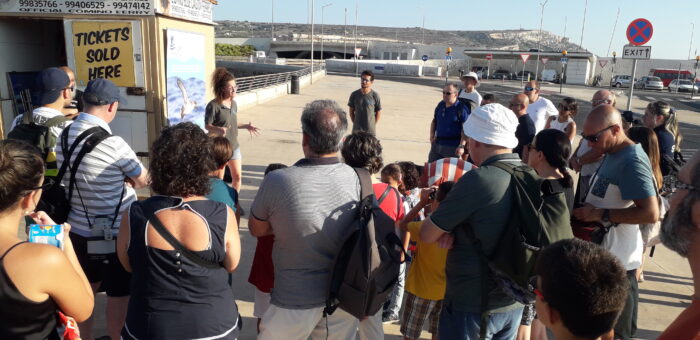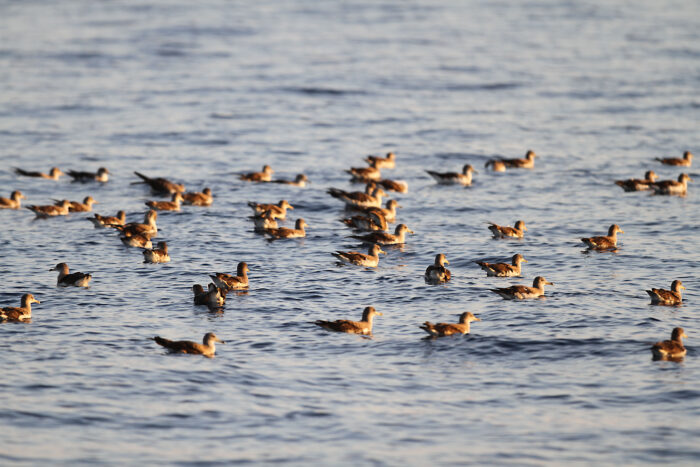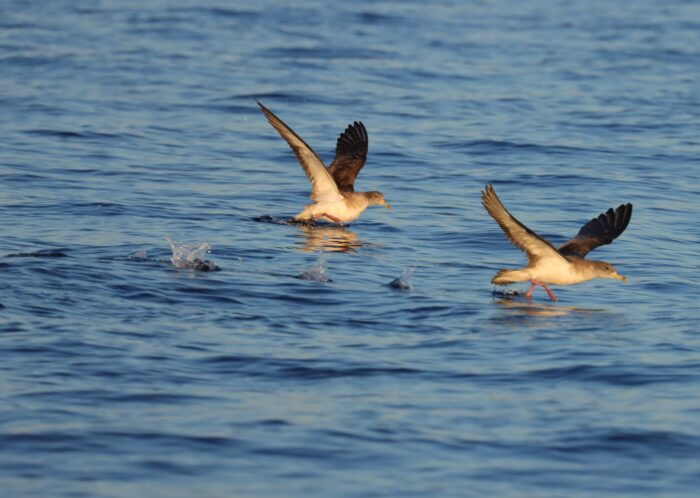Hundreds of people, amongst them families and children, during July had the opportunity to enjoy one of the most spectacular natural phenomena that occur during this time of year when hundreds of Scopoli’s Shearwaters gather in flocks under Ta’ Ċenċ Cliffs at sunset before returning to their nests in these Gozitan cliffs.
This opportunity is provided every year by BirdLife Malta, which organises boat trips to Ta’ Ċenċ so that the general public can see these seabirds up close during their breeding season.
Ta’ Ċenċ is home to the largest colony of breeding Scopoli’s Shearwater (Ċiefa in Maltese) in the Maltese Islands and due to this, this area is classified as an Important Bird Area (IBA) and is protected as a Natura 2000 site (Żona fil-Baħar madwar Għawdex.) When sailing through this area, mariners are also required to comply with Notice to Mariners No 44 of 2020, which stipulates that they decrease the velocity of their vessels so that they do not disturb the shearwaters resting on the sea surface.
Malta is home to 2% of the global population of this seabird – between 3,000 and 4,000 pairs of Scopoli’s, of which 1,000 breed in this area of Gozo. This mysterious seabird spends its life on the water and returns to land only to nest. It is easily recognised by its greyish-brown back, white belly and yellow bill.
Scopoli’s Shearwaters are known for the way they congregate in large groups known as rafts during their breeding season, when they can be observed flying low over the water, waiting for sundown, before they return into the cliffs to their nests. This natural phenomenon provides a beautiful spectacle which repeats itself for the duration of the breeding season of these birds, peaking in June and July. This is a main characteristic of this bird which we see shearing the waves at this time – a characteristic aptly describing its name ‘shearwater’.
Scopoli’s Shearwaters lay only one egg per year, and this is why it is crucial that this seabird is well protected because if the egg is lost (and the Scopoli’s Shearwater currently faces various challenges including predation, development and light pollution), the population of this Vulnerable protected seabird will continue to decline.
This year BirdLife Malta organised four of these trips for the general public, which were all fully-booked. We also led a special exclusive trip for the members of our Kids Birding Club and their families. Joined by members of our seabird team, it was a great opportunity for the young, budding birders to join more experienced birders and observe such enigmatic birds up close. The kids also got to speak with experts about how to identify the different shearwater species, and get some tips on how to photograph them. The birds complied and gave good views and offered good photographic opportunities as well!
Presently BirdLife Malta is leading a scientific study on another seabird which breeds in Malta and which is endemic to the Mediterranean – the Yelkouan Shearwater (Maltese name: Garnija). This bird is another seabird species which breeds in several cliffs in the Maltese Islands and the LIFE PanPuffinus! project – a five-year-long collaboration between BirdLife Partners from five countries (Malta, France, Greece, Portugal and Spain) and locally the Department of Fisheries and Aquaculture – is working to improve the conservation status of this bird which is under threat. The project is addressing two main threats these seabirds meet throughout their entire life cycle: predation by invasive mammal species on land, and accidental capture by fishing gear (bycatch) at sea.
During one of this year’s boat trips we were even lucky to spot a number of Yelkouan Shearwaters apart from the Scopoli’s. Like Scopoli’s, during the daytime Yelkouan Shearwaters are wandering the sea looking out for fish, squids or crustaceans. When darkness is about to fall, they gather on the sea, floating all together not far from the colony. Shearwaters assess the threat of predation by waiting until complete darkness to return to their burrow and feed their chicks. This is also thought to be an opportunity for these birds to interact, exchanging information and communicating, and increase foraging success.
We call on members of the public to do their part to decrease the dangers seabirds face by ensuring they don’t leave trash in the countryside, which in turn leads to an increase in rats. On the other hand we encourage fishers to contact BirdLife Malta so that together we can find solutions to the bycatch problem through several measures and initiatives which can be adopted.
The €3.45 million LIFE PanPuffinus! project is co-funded by the LIFE programme of the European Union (EU) and Malta’s Ministry for Agriculture, Fisheries and Animal Rights.
By Nathaniel Attard, BirdLife Malta Communication Manager





















